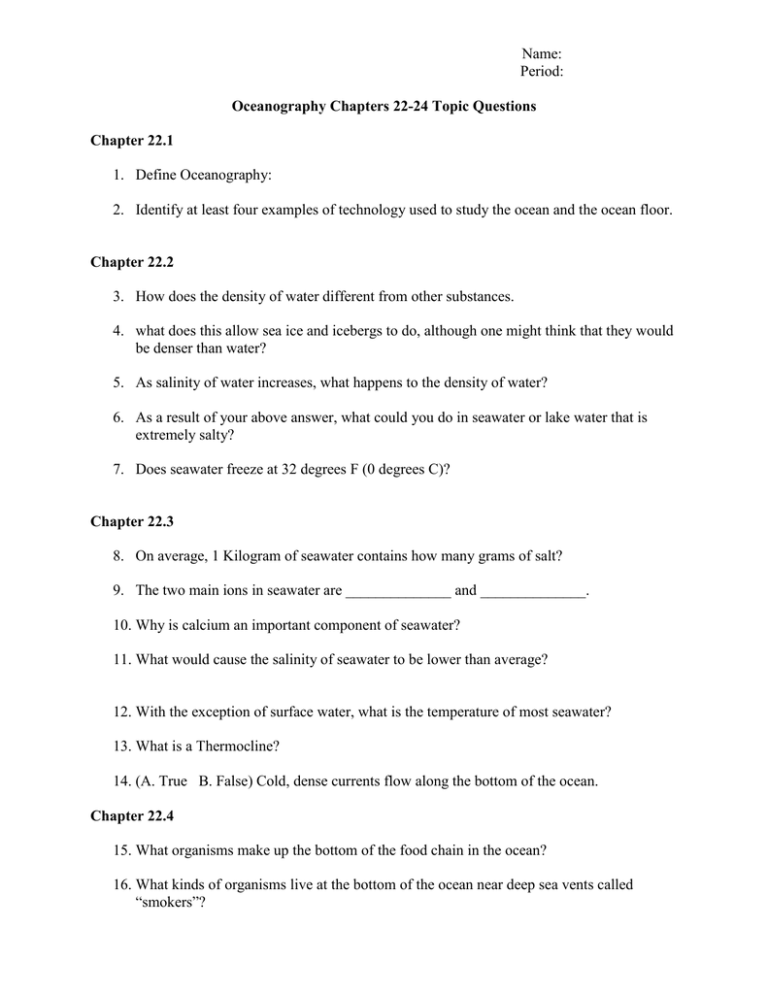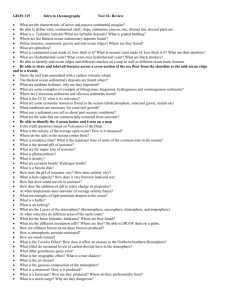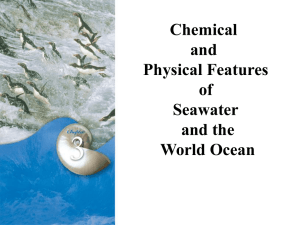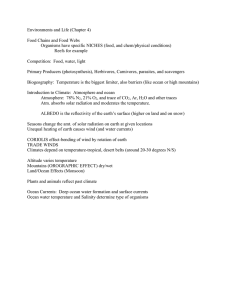Name: Period: 1. Define Oceanography:
advertisement

Name: Period: Oceanography Chapters 22-24 Topic Questions Chapter 22.1 1. Define Oceanography: 2. Identify at least four examples of technology used to study the ocean and the ocean floor. Chapter 22.2 3. How does the density of water different from other substances. 4. what does this allow sea ice and icebergs to do, although one might think that they would be denser than water? 5. As salinity of water increases, what happens to the density of water? 6. As a result of your above answer, what could you do in seawater or lake water that is extremely salty? 7. Does seawater freeze at 32 degrees F (0 degrees C)? Chapter 22.3 8. On average, 1 Kilogram of seawater contains how many grams of salt? 9. The two main ions in seawater are ______________ and ______________. 10. Why is calcium an important component of seawater? 11. What would cause the salinity of seawater to be lower than average? 12. With the exception of surface water, what is the temperature of most seawater? 13. What is a Thermocline? 14. (A. True B. False) Cold, dense currents flow along the bottom of the ocean. Chapter 22.4 15. What organisms make up the bottom of the food chain in the ocean? 16. What kinds of organisms live at the bottom of the ocean near deep sea vents called “smokers”? Chapter 23.1 17. How do oceanographers study the ocean floor? Chapter 23.2 18. What is the continental shelf? 19. How are active continental margins different from passive continental margings? 20. Submarine canyons are usually associated with ______________ on land. Chapter 23.3 21. Deep-sea trenches are associated with: 22. Deep-ocean vents are associated with: 23. Mid-ocean ridges form where? 24. Most seamounts are ______________ in origin. Chapter 23.4 25. The four types of seafloor sediments include: 26. Seafloor sediments are classified as: Chapter 24.1 27. What is an ocean current? 28. Surface currents are driven primarily by: 29. The direction in which ocean currents flow is influenced by the ______________ Effect. 30. Circular ocean currents in the northern hemisphere flow in which direction, clockwise or counterclockwise? What about those in the southern hemisphere? 31. Currents flowing toward the equator carry (A. warm B. cold) water, and currents flowing away from the equator carry (A. warm B. cold) water. 32. Westerlies blow from ______________ to ______________. 33. The Gulf Stream carries warm water that originates and ends where? 34. Why is the Labrador Current hazardous to shipping going from Europe to North America? Chapter 24.2 35. Deep-sea currents are driven by ____________ and differences in ______________. 36. Where do density currents flow? 37. How long do these currents circulate in the deep ocean before resurfacing? 38. What are some causes of changes in seawater density? 39. As seawater freezes and forms sea ice, what happens to the salt that was in it? 40. What does this do to the density of the water that does not form ice? As a result, what does it do? 41. What does evaporation do to the density of the water of the Mediterranean? 42. Why are upwellings important to ocean food chains? Chapter 24.3 43. What causes tides? 43. What affects the range of high and low tides in a certain location?






